6 Ways to Record Audio on Mac [Internal & External]
Mac doesn't support the internal audio recording. So you need an internal audio recording software to record system audio on a Mac. Moreover, there are many scenarios in which you need to record audio on Mac from internal and external sources.
| Tool | Why Choose It |
| AnyRec Screen Recorder | Record system and microphone input on Mac flexibly. |
| QuickTime Player + BlackHole | Record internal audio on Mac through virtual driver. |
| Voice Memos | Record and sync voice across iOS and Mac devices. |
| Audacity + BlackHole | Record system sound on Mac. |
| GarageBand | Record vocals and instruments in multiple audio tracks. |
| Zoom + QuickTime Player | Record computer audio temporarily. |
Record Internal and External Audio on Mac with AnyRec Screen Recorder
Best for: Easy Mac audio recordings (from all sources) for beginners.
You can record browser audio, program audio, microphone sound, online classes, lectures, online music, voiceovers, and almost all sounds on Mac by using AnyRec Screen Recorder. Beyond its audio recorder, you can trim unwanted audio clips before exporting. If you want to record playlists and other audio for hours, you can schedule a task to start and stop audio recordings automatically. Moreover, its video recorder, window recorder, game recorder, and screen capture tool can meet your demands in most scenarios.
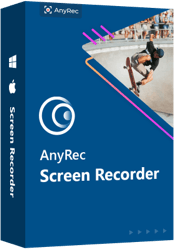
Record system audio and microphone audio on Mac simultaneously or separately.
Trim, convert, and compress audio recordings.
Export audio to MP3, M4A, WMA, FLAC, CAF, OGG, and OPUS.
Record audio on MacBook Air/Pro up to macOS 26 Tehoe.
Secure Download
Secure Download
1. Open AnyRec Screen Recorder. Click the "Audio Recorder" button.

2. Turn on the "System Sound" and "Microphone" toggle buttons according to your needs.
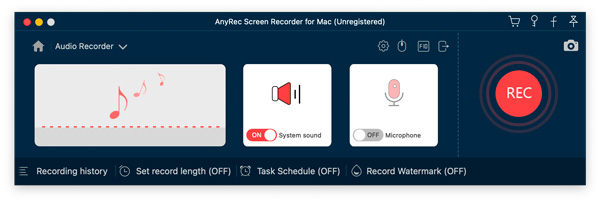
3. Click the "REC" button to start Mac audio recording. Once you stop it, you can prelisten, trim, save, or share this audio file within the program.
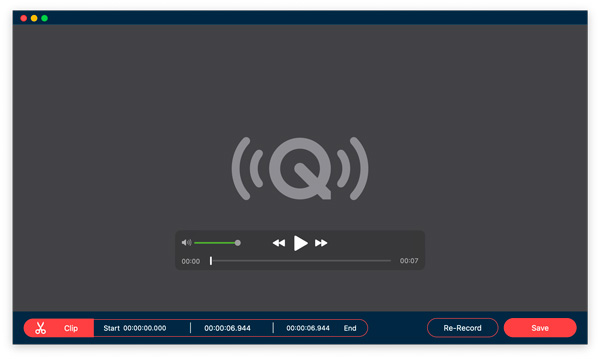
Secure Download
Secure Download
Record Internal Audio on Mac with QuickTime Player + BlackHole
Best for: Simple audio recording and then saving to M4A format on Mac.
Most Mac users are familiar with QuickTime Player as a powerful media player and recorder. But the first time you record Mac audio with QuickTime Player, you must first install BlackHole 2ch or the Soundflower add-on. Change sound settings with this virtual audio recording tool. After that, you can do an internal audio recording on a Mac. This also works for the audio recorder from the Command Shift and 5 shortcut combinations on Mac.
- 1. Download BlackHole from its official website.
- 2. Install with the on-screen prompts. Open QuickTime Player from Launchpad. You can also find QuickTime by pressing Command, Shift, and 5 on your keyboard.
- 3. Unfold the "File" top list. Click "New Audio Recording" from this list.
- 4. Click the white down arrow icon. Select "BlackHole 2ch" under "Microphone".
- 5. Now you can record audio on a Mac with QuickTime Player.
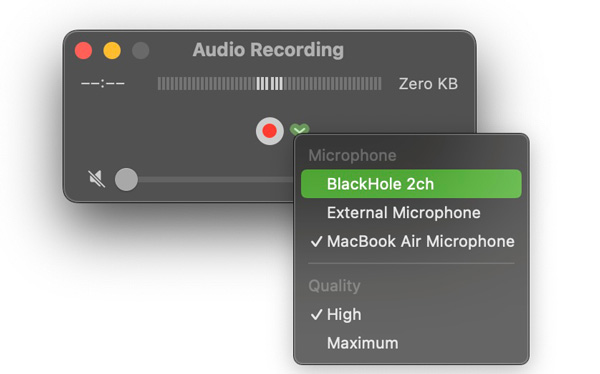
- Pros
- Create audio-only recordings with QuickTime Player pre-installed programs.
- Record voice from the built-in or external microphone on Mac.
- Cons
- No default internal audio recording support.
- Record and save audio to M4A only. You may need to convert M4A to MP3 for further editing.
Record Voice on Mac with Voice Memos
Best for: Record voice and save it to M4A format on Mac. Integrate with iCloud sharing.
Voice Memos can turn your Mac, iPhone, iPad, and even Apple Watch into a portable audio recorder. So you can quickly record thoughts, ideas, lectures, and meetings. To share voice memos to non-Apple devices, manually convert them to MP3.
1. Open Launchpad and search for Voice Memos.
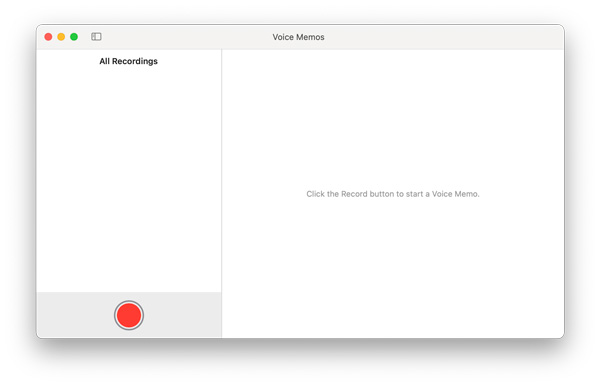
2. Click the "Record" button, which is located in the lower left corner.
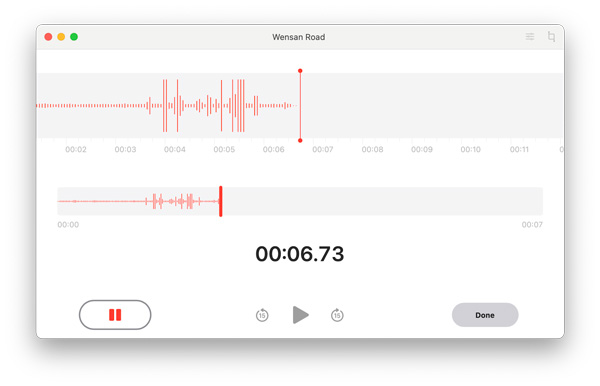
3. Click the "Stop" button to finish Voice Memos recordings without a time limit.
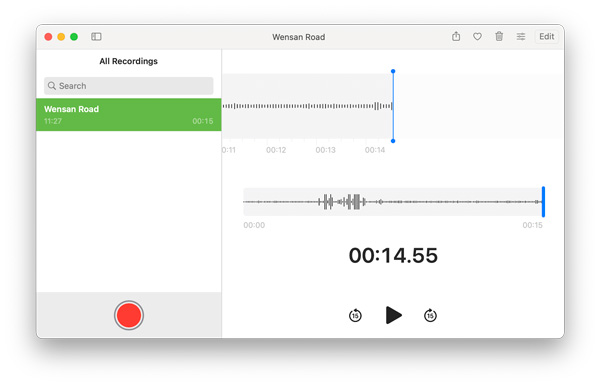
4. Right-click on this audio file. You can edit, trim, duplicate, or get more editing tools.
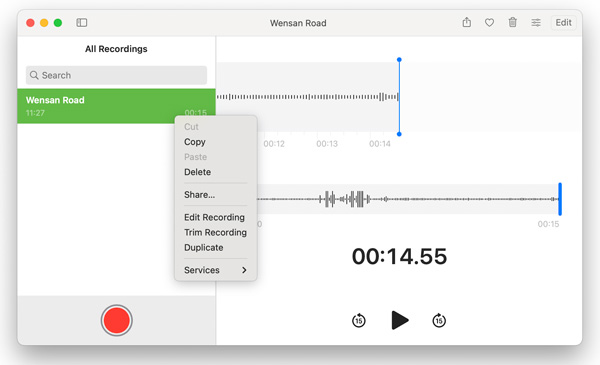
- Pros
- Free to record a microphone voice on a Mac.
- Sync voice memos with iPhone and iPad via iCloud.
- Cons
- Cannot record internal audio on Mac with Voice Memos.
- Voice Memo recordings may be compressed with low bitrates.
Capture Internal Audio on Mac with Audacity + BlackHole
Best for: Free to record and edit audio on Mac, including noise reduction, multi-tracking editing, and more.
If you want more control options than Voice Memos and QuickTime Player, Audacity is a great choice. You can capture audio through your microphone and edit it with filters and effects. Whether you want to record a podcast, narration, or personal notes, you can easily record, edit, and export your voice files. But if you want to record internal audio on a Mac with Audacity, you need to install BlackHole or other virtual audio drivers first.
- 1. Open Audacity. Plug your USB microphone into your Mac computer.
- 2. Choose your connected microphone and configure audio settings in the Audio Setup toolbar.
- 3. Click the "Record" button. Start capturing the microphone voice on a Mac.
- 4. Click the "Stop" button to finish it. You can play and export your file as WAV, MP3, and other formats.
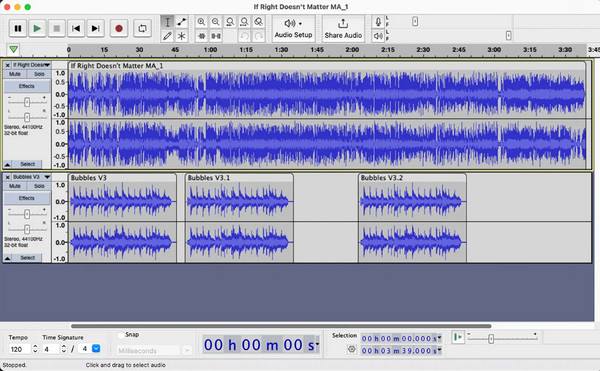
- Pros
- A free and open-source audio recorder for all Mac users.
- Support voice recording and multi-track editing.
- Cons
- The Audacity interface is outdated for some users.
- Need to install an external driver to record internal audio with Audacity.
Record Music on Mac with GarageBand
Best for: Record high-quality voiceovers, podcasts, and music through a microphone on a Mac using GarageBand.
GarageBand is your free voice recorder and music creation software for all Mac users. You can record, edit, and mix music without expensive studio gear. GarageBand provides presets for instruments and vocals. Moreover, you can edit voice recordings with custom presets.
- 1. Open GarageBand. Click the "New Project" button. Click the "Empty Project" button to start a new project.
- 2. Click the "Mic or Line Audio" button as the track type.
- 3. Go to the "Details" panel. Check if your external (or built-in) microphone is selected as the input device. Then click the "Create" button to move on.
- 4. Open your new project with a microphone track. To simplify your workspace, click the "Library" and "Smart Controls" buttons.
- 5. Click the "Metronome" and "Count" buttons to turn them off.
- 6. Click the "Record" button to start recording microphone audio on Mac.
- 7. Now click the "Stop" button to finish the GarageBand audio recording.
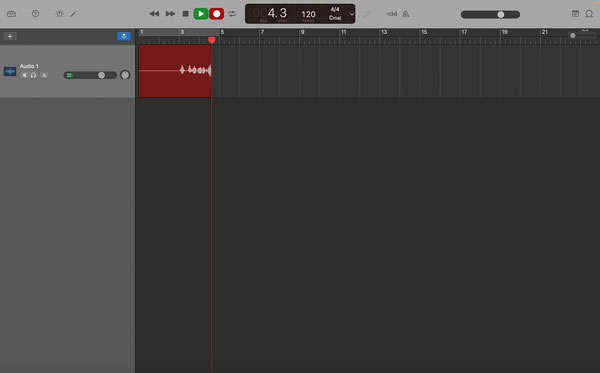
- Pros
- Free record voice on Mac with built-in guitar, piano, and more instruments.
- Integrate with Apple hardware and software seamlessly. You can import voice memos into GarageBand for editing, too.
- Cons
- Cannot record internal audio on a Mac with GarageBand directly.
- GarageBand may cause lag, crash, or slow performance on older Macs while editing complex projects.
Record Audio on Mac from the Internet Using Zoom + QuickTime Player
Best for: Record audio from YouTube and other streaming sites without a virtual audio driver.
If you don't want to install any new program on your computer, you can use the combination of Zoom and QuickTime Player as your internal audio recording software. By sharing the computer audio within Zoom, you can use QuickTime Player to record online streaming music.
- 1. Start a Zoom meeting with yourself. Click the "Share Screen" button.
- 2. Click the "Computer Audio" button in the "Advanced" tab. Later, click the "Share" button to move on.
- 3. Then open QuickTime Player. Click the "New Audio Recording" option from the "File" drop-down list at the top.
- 4. Click the down arrow icon next to the "Record" button. Click the "ZoomAudioDevice" option from the list.
- 5. Now play the song and click the "Record" button in QuickTime Player.
- 6. You can record internal audio on a Mac with QuickTime Player and Zoom successfully.
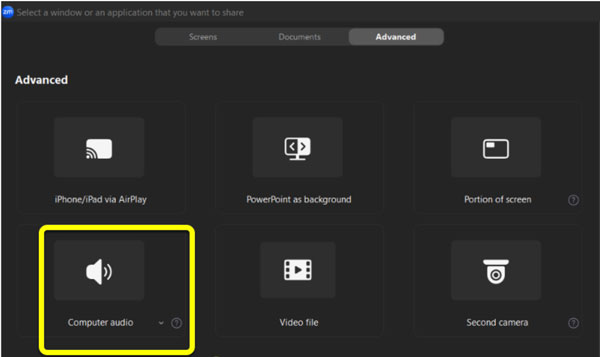
- Pros
- To record desktop audio on Mac, you don't need to install BlackHole, Soundflower, or other virtual audio drivers.
- You can record not only the streaming audio but also the screen video with streaming audio. Select the "ZoomAudioDevice" option as the input audio source in QuickTime Player.
- Cons
- Zoom is not a local audio capture tool. When recording Mac audio with Zoom and QuickTime Player, you may encounter latency, compression, or slight quality loss.
- Some Mac recordings have silent audio due to the wrong audio sources.
Conclusion
Recording internal and external audio on a Mac can be easy. You can use QuickTime Player to create voice recordings. While Voice Memos and GarageBand empower creators and musicians. If you want to save streaming audio, record clear narration, and capture all types of audio on Mac, AnyRec Screen Recorder is your best choice. Just open the program and use its Audio Recorder. You can record internal audio and microphone voice on Mac flexibly.
